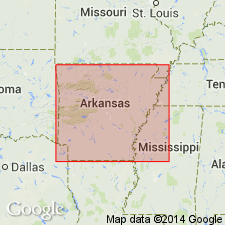
- Usage in publication:
-
- Blaylock sandstone*
- Modifications:
-
- Original reference
- Dominant lithology:
-
- Sandstone
- Shale
- AAPG geologic province:
-
- Ouachita folded belt
Summary:
Pg. 30, 36. Blaylock sandstone. Fine-grained to medium-grained sandstone of dove, dark gray, or green color, interbedded with dark-colored often black, and fissile shale. Thickness 1,500 feet. In parts, through 100 or more feet, consists almost wholly of sandstone; in other parts is made up of alternating beds of sandstone and shale. The sandstone is usually in layers 1 to 6 inches thick and bedding is very even. Some of layers are quartzitic and contain numerous quartz veins; other thin layers closely resemble chert. Overlies Polk Creek shale. Underlies, probably unconformably, Missouri Mountain slate. [Age is Early Silurian.]
[Named from Blaylock Moutain, Montgomery Co., AR. Recognized in southwestern AR and southeastern OK.]
Source: US geologic names lexicon (USGS Bull. 896, p. 212).
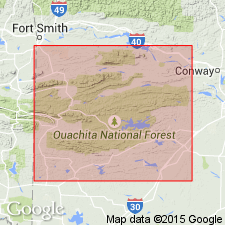
- Usage in publication:
-
- Blaylock sandstone
- Modifications:
-
- Original reference
- Dominant lithology:
-
- Sandstone
- AAPG geologic province:
-
- Ouachita folded belt
Summary:
Pg. 557. Blaylock sandstone. Sandstone unconformably underlying Slatington shale [Missouri Mountain slate] and overlying Polk Creek shale. [Age is Early Silurian.]
Source: US geologic names lexicon (USGS Bull. 896, p. 212).
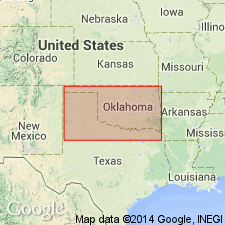
- Usage in publication:
-
- Blaylock sandstone*
- Modifications:
-
- Mapped 1:500k
- Dominant lithology:
-
- Sandstone
- AAPG geologic province:
-
- Ouachita folded belt
Summary:
Blaylock sandstone. Mapped as Silurian.
Source: US geologic names lexicon (USGS Bull. 1200, p. 383-384).
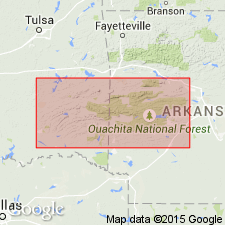
- Usage in publication:
-
- Blaylock sandstone
- Modifications:
-
- Areal extent
- AAPG geologic province:
-
- Ouachita folded belt
Summary:
Pg. 39. Blaylock sandstone. Consists of thin-bedded sandstones and dark shales which weather red or brown. Sandstones are silty, normally greenish gray or brown on fresh fracture. Thickness 670 to slightly over 800 feet. Overlies Polk Creek shale; underlies Missouri Mountain shale. [Age is Silurian.]
Source: US geologic names lexicon (USGS Bull. 1200, p. 383-384).
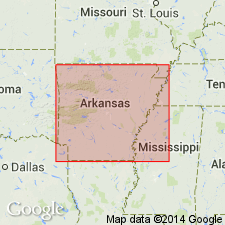
- Usage in publication:
-
- Blaylock Sandstone*
- Blaylock Formation*
- Modifications:
-
- Overview
- AAPG geologic province:
-
- Ouachita folded belt
Summary:
Pg. 20-21. Blaylock Sandstone; Blaylock Formation. Fine- to medium-grained sandstone of tan, dark gray, or greenish color, interbedded with dark-colored to black fissile shale. Thickness as much as 1,200 feet along southwestern part of outcrop area in Arkansas, but thins dramatically to north where it is frequently represented by only 5 to 20 feet of olive gray shale. Conformably overlies the Polk Creek. Age is Silurian.
Recognized in Ouachita Mountains, west-central AR, and in southeastern OK.
Source: Publication.
For more information, please contact Nancy Stamm, Geologic Names Committee Secretary.
Asterisk (*) indicates published by U.S. Geological Survey authors.
"No current usage" (†) implies that a name has been abandoned or has fallen into disuse. Former usage and, if known, replacement name given in parentheses ( ).
Slash (/) indicates name conflicts with nomenclatural guidelines (CSN, 1933; ACSN, 1961, 1970; NACSN, 1983, 2005, 2021). May be explained within brackets ([ ]).

